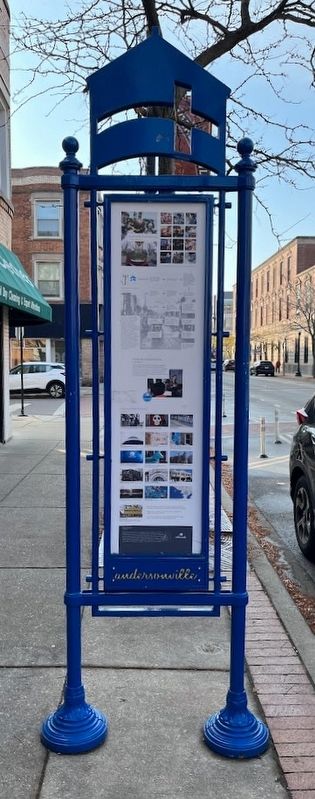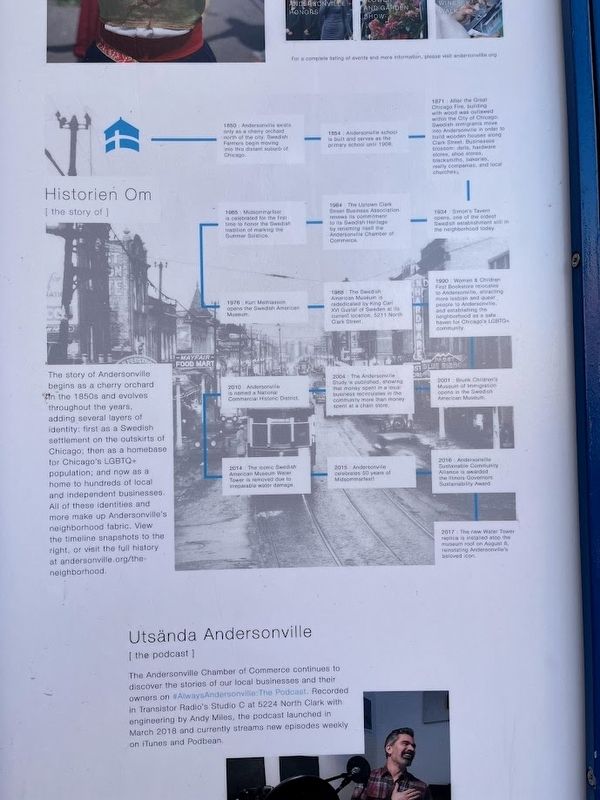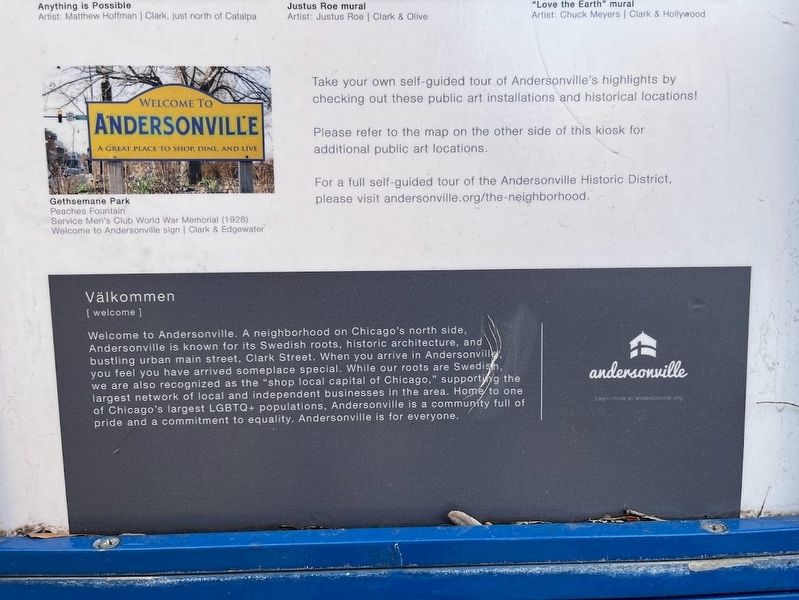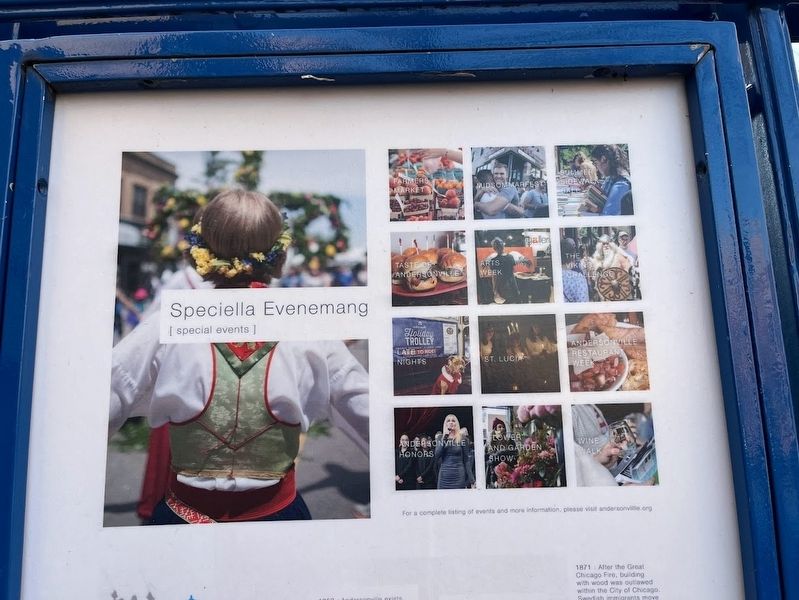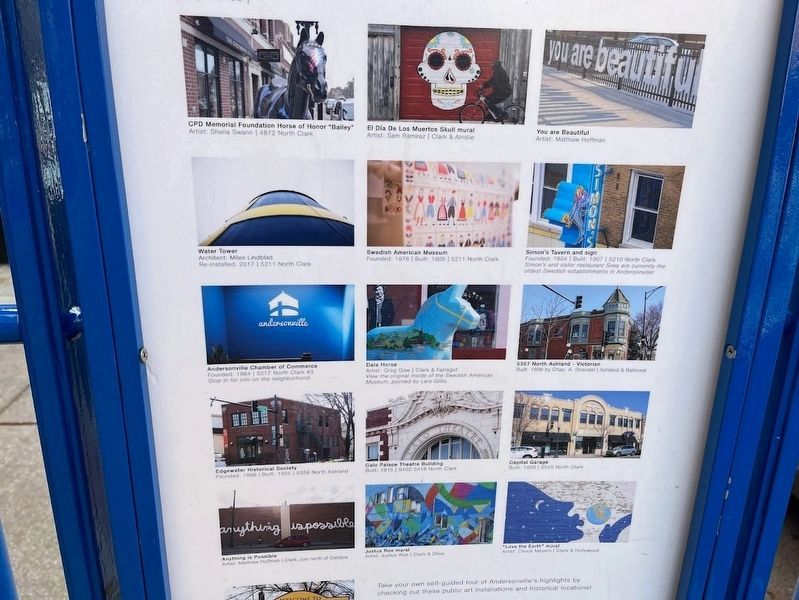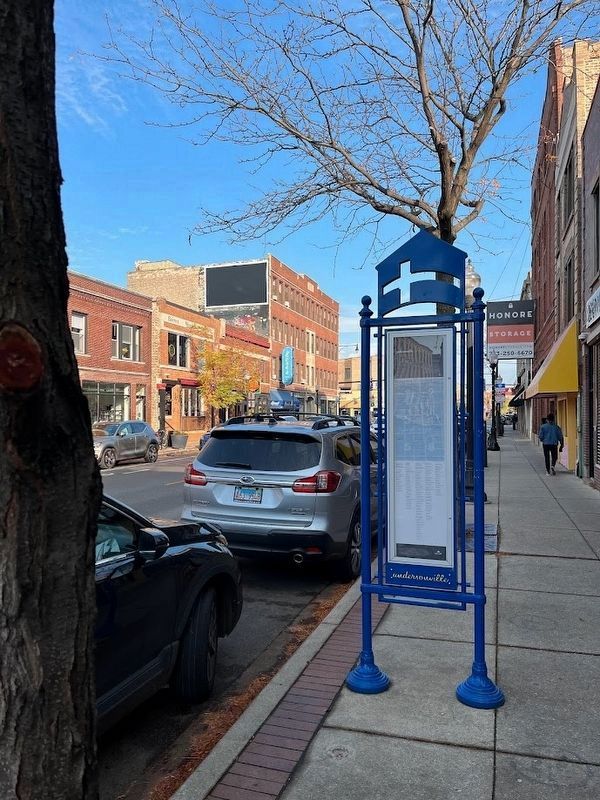Andersonville in Chicago in Cook County, Illinois — The American Midwest (Great Lakes)
Andersonville
1850 : Andersonville exists only as a cherry orchard north of the city. Swedish Farmers begin moving into this distant suburb of Chicago.
1854 : Andersonville school is built and serves as the primary school until 1908.
1871 : After the Great Chicago Fire, building with wood was outlawed within the City of Chicago. Swedish immigrants move into Andersonville in order to build wooden houses along Clark Street. Businesses blossom: delis, hardware stores, shoe stores, blacksmiths, bakeries, realty companies, and local churches.
1934 : Simon's Tavern opens, one of the oldest Swedish establishment still in the neighborhood today.
1964 : The Uptown Clark Street Business Association renews its commitment to its Swedish Heritage by renaming itself the Andersonville Chamber of Commerce.
1965 : Midsommarfest is celebrated for the first time to honor the Swedish tradition of marking the Summer Solstice.
1976 : Kurt Mathiasson opens the Swedish American Museum.
1988 : The Swedish American Museum is rededicated by King Carl XVI Gustaf of Sweden at its current location, 5211 North Clark Street.
1990 : Women & Children First Bookstore relocates to Andersonville, attracting more lesbian and queer people to Andersonville, and establishing the neighborhood as a safe haven for Chicago's LGBTQ+ community.
2001 : Brunk Children's Museum of Immigration opens in the Swedish American Museum.
2004 : The Andersonville Study is published, showing that money spent in a local business recirculates in the community more than money spent at a chain store.
2010 : Andersonville is named a National Commercial Historic District.
2014 : The iconic Swedish American Museum Water Tower is removed due to irreparable water damage.
2015 : Andersonville celebrates 50 years of Midsommarfest!
2016 : Andersonville Sustainable Community Alliance is awarded the Illinois Governors Sustainability Award.
2017 : The new Water Tower replica is installed atop the museum roof on August 8, reinstating Andersonville's beloved icon.
[welcome]
Erected by Andersonville Chamber of Commerce.
Topics. This historical marker is listed in these topic lists: Immigration • Industry & Commerce • Settlements & Settlers. A significant historical date for this entry is August 8, 1850.
Location. 41° 58.53′ N, 87° 40.096′ W. Marker is in Chicago, Illinois, in Cook County. It is in Andersonville. Marker is on Clark Street north of Winona Street. The marker is on the east side of Clark Street, a short walk south of the intersection with Foster Avenue. Touch for map. Marker is at or near this postal address: 5137 North Clark Street, Chicago IL 60640, United States of America. Touch for directions.
Other nearby markers. At least 8 other markers are within walking distance of this marker. Andersonville School (within shouting distance of this marker); St. Boniface Union Soldiers Monument (approx. 0.3 miles away); Essanay Studios (approx. 0.3 miles away); First Telephone System (approx. 0.6 miles away); Carl Sandburg (approx. 0.7 miles away); WWI Memorial (approx. ¾ mile away); Rosehill Cemetery Entrance (approx. 0.9 miles away); Thomas Edwin Greenfield Ransom (approx. 0.9 miles away). Touch for a list and map of all markers in Chicago.
More about this marker. In addition to the timeline and short history of Andersonville, the top part of the marker includes a list of special neighborhood events, the middle has a description of an Andersonville-themed podcast, and near the bottom are landmark sites in the neighborhood.
The rear of the sign has a map of the Andersonville neighborhood and important locations.
Regarding Andersonville. The national commercial historic district referenced on the sign runs on Clark Street from the 4800 N. (3½ blocks south of here) to 5800 N. (about 6½ blocks north).
Who exactly the neighborhood is named
after cannot be said for certain. One possibility is a farmer named John Anderson, who bought land south and west of Foster and Clark (where this marker can be found). In the 1850s, Anderson was the highway commissioner for Ridgeville, a township that extended from Irving Park Road (where Graceland Cemetery is today) north to what today is Central Street in the northern suburb of Evanston. Other researchers believe it may actually have been named after Reverend Paul Andersen (whose name was often spelled with an o), Chicago's first Lutheran minister who settled in Lake View sometime after 1850.
Also see . . .
1. Andersonville and Edgewater. A history of the neighborhood from the Edgewater Historical Society. (Submitted on November 6, 2023, by Sean Flynn of Oak Park, Illinois.)
2. Andersonville Chamber of Commerce. (Submitted on November 6, 2023, by Sean Flynn of Oak Park, Illinois.)
Additional keywords. LGBT, LGBTQ, 🏳️🌈
Credits. This page was last revised on November 26, 2023. It was originally submitted on November 6, 2023, by Sean Flynn of Oak Park, Illinois. This page has been viewed 46 times since then and 16 times this year. Photos: 1, 2, 3, 4, 5, 6. submitted on November 6, 2023, by Sean Flynn of Oak Park, Illinois. • Devry Becker Jones was the editor who published this page.
Editor’s want-list for this marker. Clear, readable closeup photo of the marker. • Can you help?
